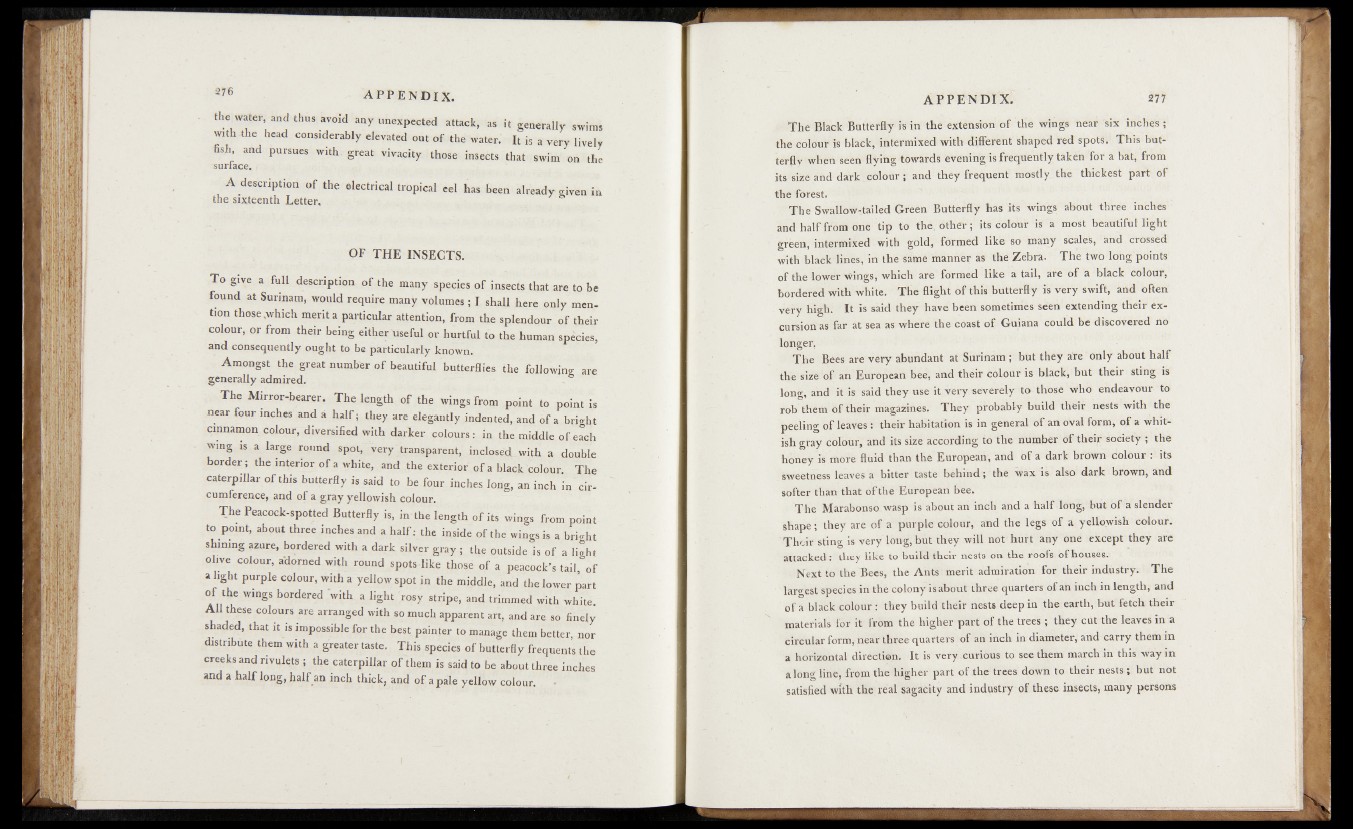
th e ^ t e * , and d e v o i d any unexpected attack,"** it g en ia lly Wims
with the head considerably elevated oat of the water.' It is a very lively
-fisji, and pursues with, great vivacity: those insects that swim on the
surface.,
A description of the electrical tropical eel has heen already given in
the sixteenth Letter,
OF THE INSECTS,
To give a full description o f the many species of insects that are to be
found at Surinam, would require many volumes; I shall here only men-
tion those jwhich merit a particular attention, from the splendour of their
colour, or from their being either Useful or hurtful to the human species,
and consequently ought to be particularly known.
Amongst the great number o f beautiful butterflies the following are
generally admired.
The Mirror-bearer; The length of the wings f t o , to point is
inear four inches and a half j they, are elegantly indented, and of a bright
cinnamon. colourrdiyersjfied with darker colours: in the.middle,
wmg is a large round spot, “very transparent, inclosed, with a double
border; the interior of a white, and the exterior of a black colour; The
caterpillar of this butterfly is said to be four inches long, V m c h > circumference,
and o f a gray yellowish colour.
The Peacock-spotted Butterfly is, imthe length of its wings from pointpoint,
about three inches and a half; the inside of the wings is a bright
shining azure, bordered with a dark silver gray ; the outside is of a light
olive colour, Adorned with round spots-like those of a peacock’s tail, o f
a light purple colour, with a yellpw spot in the middle, and the lower part
o f the wings bordered ‘with, a light ypsy stripe, and trimmed with white.
A ll these colours are arranged with so much apparent art, and are so finely
shaded, that it is impossible for the best painter to manage them better,- nor
distribute them yutji a greater taste. This species o f butterfly frequents the
crepks and rivql^ts ; the caterpillar o f tfiem is said to be about three inches
and a half long, half an inch thick, and of a pale yellow colour. ,
The Black Battfefflf^Yin the extension of thë wings hëâ# %ix itiehè'^ ;
the-colour'is black, intermixed with different shaped fed spots. This butterfly
when seen-flÿihg towards evening is frequently taken for a bâ'tj from
its steë and dark,colour ; and they frequent mostly the thickest part of
the forest.
The Swallow-tailed Green Butterfly has its wings about three inches
and half froiù one tip to thë, other ; its coloilr is a'mbst beautiful light
green, intermixed with gold, formed like so many scales, and crossed
with black lines, in the same manner as 'the' Zébra. | The two Icrhg'points
of the lower wings, which ate formed like a tail, ate of a black colour,
bordered with white. The flight o f this butterfly is very swift, and often
very high. It is'said theÿ'have been sometimes seen extending thèîf êx-
cûr'sionas far at sea as whefe the coast of Guiana could be discovered no
longer.
The Bees are very abundant at Surinam ; but they ate dtily about half
the size of an European bee, and their colour is black',’but their sting is
long, and it is said they use it very severely *to- those who endeavour to
rob them of their magazines. They probably build thëif nests Ïwith the
peeling of leaves | their habitation is in general of an oval förm, of a whitish
gray colour'; and its size according to the number of theiy society ; the
honey is more fluid than the European', and of a dark brown colôur r its
sweetness leaves a bitter taste behind; the wax is also dark brown, and
softer than-that ofthé Ëuropeân bee.
The Marabonso wasp is about axi inch and a'half -long, 'but of'a slender
shape; they are o f a purple colour, and the legs of a yellowish colour.
Their sting is very long, but they will not hurt 'any One except they are
attacked!: theÿ life to buifdfheir nests ohithe roofs-bf houses.': t
-Next to the "Bees, the Ants merit admiration for their industry. The
largest species in the colony is about three quarters of ati inoh in length, and
of a black colour: they build their nests deep in the-earth, but fetch their
tnateriafTor it from the higher part of the trees; they cut the leaves m?a-
circular form,-near three quarters of ah inch in diameter, and carry them in
a horizontal direction. It is' very-curious to see them march in this way in
a lónglitiè, from the higher part cxflhe trees dowh to their nests.;: but nbt
satisfied with the real sagacity and industry óf these insects, many persons